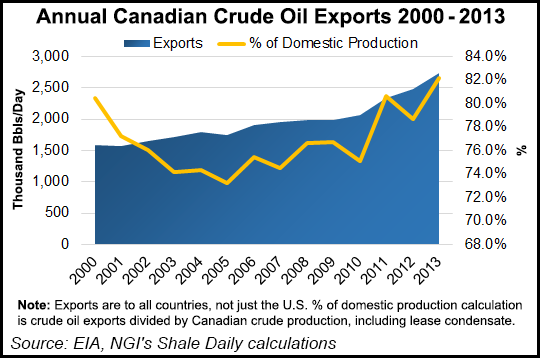Potential U.S. Crude Exports Making Waves in Alberta
A review of Alberta government royalties says Canada’s chief natural gas and oil-producing jurisdiction must accept and cope with painful reality that the shale revolution turned its prime export customer into a rival supplier.

“The United States is going to be our competitor,” review panel Chairman Dave Mowat told crowded meetings in the provincial corporate capital, Calgary, and political capital Edmonton. “One thing we are very aware of is the industry has changed dramatically.”
The royalty review is a government counterpart to industry efforts to adapt by breaking into overseas markets with 26 liquefied natural gas (LNG) export projects and proposals for new oil pipelines to tanker docks on Canada’s Pacific and Atlantic coasts.
In Canadian industry forecasts, campaigns in Washington, DC, to end prohibition against U.S. overseas exports raise the possibility that U.S. competition for gas sales in Ontario and Quebec will spread to international oil markets.
A steep decline in the Alberta treasury’s revenues from provincial government-owned natural resources highlights the scale of change driven by shale gas abundance that cut prices, shrank exports to the United States and accelerated eastern Canadian imports.
On the eve of the shale revolution — in the government fiscal year of April 1, 2005, to March 31, 2006 — Alberta treasury resource revenues hit C$14.4 billion (US$11 billion). The gravy included C$8.3 billion (US$6.4 billion) in natural gas royalties alone, plus C$3.4 billion (US$2.6 billion) from gas and oil lease auctions.
For the current 2015-2016 fiscal term the treasury take is forecast to be down from the 2005-2006 peak by 75% to C$3.6 billion (US$2.8 billion). Gas royalties have all but vanished by shrinking to C$392 million (US$302 million). Lease auctions, a barometer of industry intentions, have also shriveled to C$157 million (US$121 million). Growing oilsands plants, recognized as high-cost producers by royalties that apply only to after-expenses profits, will not offset the losses.
At a crowded meeting in the downtown heart of corporate Calgary, the response to the review panel appointed by the left-leaning New Democratic Party regime elected in May was tinged with right-wing political frustration. A message in bold, uppercase letters written on flip charts meant to collect public goals for royalties expressed widespread suspicion that the exercise is a prelude to a radical money grab: “NDP IDEOLOGY WILL BE THE ECONOMIC END OF ALBERTA.”
The new regime will announce its first budget on Oct. 27. So far the only moves on industry have been a two percentage-point rise in corporate income tax on profitable firms to 12% and enactment of phased increases to carbon emissions penalties that also figured in the former Conservative regime’s climate change policy.
The NDP, which in Alberta has more populist than socialist roots, infused the four-member royalty review panel with business and financial sensitivity. Chairman Mowat is president of Alberta Treasury Branches, a government-owned bank with a clientele of home grown firms in the gas and oil industry. Peter Tertzakian is chief energy economist of Calgary investment house ARC Financial. Leona Hanson is a project management consultant and mayor of a northern Alberta gas- and oilfield service center, Beaverlodge. Annette Trimbee is a former Alberta deputy finance minister.
The review panel’s budget of C$3-3.5 million (US$2.3-2.7 million) includes technical consulting services by Wood Mackenzie and a senior Calgary engineering and earth sciences firm, GLJ Petroleum.
The goal is a durable “framework” policy to “optimize” Alberta’s government-owned resource endowment by collecting a fair public share of production revenues flexibly, in a way that also helps industry cope with fat and lean times, Mowat emphasized. His agenda calls for a report by the end of this year. The government has allowed itself plenty of time to respond by pledging to refrain from making royalty changes until 2017.
© 2024 Natural Gas Intelligence. All rights reserved.
ISSN © 2577-9877 | ISSN © 2158-8023 |
